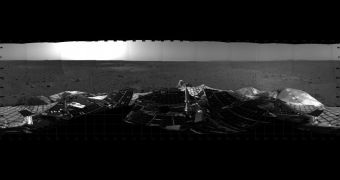If the Mars Exploration Rover (MER) Spirit were still alive and operational today, then scientists and mission controllers at NASA would be celebrating the machine's 10-year anniversary. Unfortunately, the spacecraft became trapped in a patch of loose soil on the Martian surface on May 1, 2009.
Spirit landed on the surface of Mars on January 4, 2004, after launching aboard a Delta II delivery system on June 10. 2003. Liftoff occurred from the Space Launch Complex 17 at the Cape Canaveral Air Force Station, in Florida. The robot weighed around 185 kilograms (410 pounds).
The rover was built and managed by experts with the NASA Jet Propulsion Laboratory (JPL), in Pasadena, California, and was originally supposed to study the surface of mars for just 90 sols (Martian days), or roughly 92 Earth days. Plans called for it to drive around for 600 meters (0.4 miles).
However, the machine surprised everyone when it endured on the surface of the Red Planet for more than six years. It remained operational for a total of 2,208 sols (2,269 days), of which 1,892 sols (1,944 days) were spent mobile. The entire mission lasted 2,623 sols, or 2,695 days.
Simply put, these numbers indicate that the robot endured on Mars around 21.6 times longer than its original mission design called for. During this period, Spirit drove more than 12 times the initially-planned distance, with its odometer reaching 7.73 kilometers (4.8 miles) at mission end.
The spacecraft met its demise after driving into a patch of loose soil subsequently called Troy, which was disguised as normal-looking soil. One of its middle wheels became jammed, and researchers at JPL desperately tried to replicate the conditions at Troy here on Earth. Despite their best efforts, freeing Spirit just was not in the cards.
The machine's front right wheel was immobile since 2006, so the rover had to drive backwards for three years. Once in Troy, another wheel failed as well, so there was no way for a drive to be successful with just four operational wheels. The mission was declared a stationary science platform in late 2009.
Last contact with the rover was established on March 22, 2010, on sol 2,210. NASA scientists tried to reestablish contact using the Mars Reconnaissance Orbiter and the Mars Odyssey spacecraft, as well as the European Space Agency's Mars Express orbiter, but to no avail. Efforts were called off on May 24, 2011.
Over the course of its long-term mission, Spirit was able to send back more than 124,000 images, which revealed for the first time the amazingly-complex and intricate geological history of Mars. The explorer was also the first to hint at our neighboring world's wet past.
The rover is survived by its twin, Opportunity, which landed on Mars on January 25, 2004, and has an upcoming birthday. The latter took off from the CCAFS aboard an identical Delta II rocket, only its launch was scheduled for July 7, 2003, almost a full month after Spirit's.
Opportunity is still doing well on the surface of Mars due to the fact that it roams its surface much closer to the Equator, and therefore has access to more sunlight. This machine has exceeded its planned lifespan more than 40 times over, and will soon celebrate its 10th anniversary.

 14 DAY TRIAL //
14 DAY TRIAL //